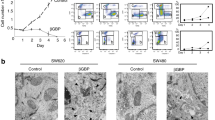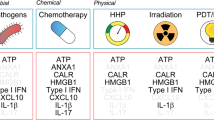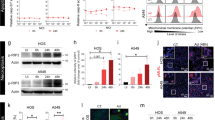Abstract
REGb cell line, a highly immunogenic tumor cell variant isolated from a rat colon cancer, yields regressive tumors when injected into syngeneic hosts. We previously demonstrated that REGb tumor immunogenicity was related to the capacity of releasing dead cells in vivo. Also, in vitro, REGb cell monolayers release dead cells, especially when cultured in serum-free medium. In the current study, we show that the release of dead cells results from an atypical death process associating features of necrosis and apoptosis. In spite of features considered as hallmarks of caspase-dependent apoptosis, including chromatin fragmentation and DNA oligonucleosomal cleavage, caspases are not activated and caspase inhibitors are ineffective to prevent REGb cell death. In contrast with a number of other types of cell death, the spontaneous death of REGb cells in culture depends on de novo protein synthesis as this death is blocked by low doses of the mRNA translation inhibitor cycloheximide. This unusual mode of cell death that associates necrotic and apoptotic features could provide optimal conditions for triggering a specific immune response.
This is a preview of subscription content, access via your institution
Access options
Subscribe to this journal
Receive 50 print issues and online access
$259.00 per year
only $5.18 per issue
Buy this article
- Purchase on Springer Link
- Instant access to full article PDF
Prices may be subject to local taxes which are calculated during checkout










Similar content being viewed by others
References
Albert ML, Sauter B, Bhardwaj N . 1998 Nature 392: 86–89
Belmokhtar CA, Hillion J, Segal-Bendirdjian E . 2001 Oncogene 20: 3354–3362
Belmokhtar CA, Torriglia A, Counis MF, Courtois Y, Jacquemin-Sablon A, Segal-Bendirdjian E . 2000 Exp. Cell Res. 254: 99–109
Bonnotte B, Favre N, Moutet M, Fromentin A, Solary E, Martin M, Martin F . 1998 J. Immunol. 161: 1433–1438
Bonnotte B, Favre N, Moutet M, Fromentin A, Solary E, Martin M, Martin F . 2000 J. Immunol. 164: 1995–2000
Caignard A, Martin MS, Michel MF, Martin F . 1985 Int. J. Cancer 36: 273–279
Chen D, Stetler RA, Cao G, Pei W, O'Horo C, Yin XM, Chen J . 2000 J. Biol. Chem. 275: 38508–38517
Dumont C, Dürrbach A, Bidere N, Rouleau M, Kroemer G, Bernard G, Hirsch F, Charpentier B, Susin SA, Senik A . 2000 Blood 96: 1030–1038
Daugas E, Susin SA, Zamzami N, Ferri KF, Irinopoulou T, Larochette N, Prevost MC, Leber B, Andrews D, Penninger J, Kroemer G . 2000 FASEB J. 14: 729–739
Enari M, Sakahira H, Yokoyama H, Okawa K, Iwamatsu A, Nagata S . 1998 Nature 391: 43–50
Famulski KS, Macdonald D, Paterson MC, Sikora E . 1999 Cell Death Differ. 6: 281–289
Gallucci S, Lolkema M, Matzinger P . 1999 Nat. Med. 5: 1249–1255
Garcia Calvo M, Peterson EP, Rasper DM, Vaillancourt JP, Zamboni R, Nicholson DW, Thornberry NA . 1998 J. Biol. Chem. 273: 32608–32613
Lee ST, Hoeflich KP, Wasfy GW, Woodgett JR, Leber B, Andrew DW, Hedley DW, Penn LZ . 1999 Oncogene. 18: 3520–3528
Li LY, Luo X, Wang X . 2001 Nature 412: 95–99
Matzinger P . 1994 Ann. Rev. Immunol. 12: 991–1045
Melcher A, Todryk S, Hardwick N, Ford M, Jacobson M, Vile RG . 1998 Nat. Med. 4: 581–587
Monney L, Otter I, Olivier R, Ozer HL, Haas AL, Omura S, Borner C . 1998 J. Biol. Chem. 273: 6121–6131
Rensing-Ehl A, Frei K, Flury R, Matiba B, Mariani SM, Weller M, Aebischer P, Krammer PH, Fontana A . 1995 Eur. J. Immunol. 25: 2253–2258
Rovere P, Vallinoto C, Bondanza A, Crosti MC, Rescigno M, Ricciardi-Castagnoli P, Rugarli C, Manfredi AA . 1998 J. Immunol. 161: 4467–4471
Sauter B, Albert ML, Francisco L, Larsson M, Somersan S, Bhardwaj N . 2000 J. Exp. Med. 191: 423–434
Shaif-Muthana M, McIntyre C, Sisley K, Rennie I, Murray A . 2000 Cancer Res. 60: 6441–6447
Sperandio S, de Belle I, Bredesen DE . 2000 Proc. Natl. Acad. Sci. USA 97: 14376–14381
Torriglia A, Perani P, Brossas JY, Altairac S, Zeggai S, Martin E, Tréton J, Courtois Y, Counis MC . 2000 Ann. NY Acad. Sci. 926: 192–203
Voehringer DW, McConkey DJ, McDonnell TJ, Brisbay S, Meyn RE . 1998 Proc. Natl. Acad. Sci. USA 95: 2956–2960
Acknowledgements
We thank Alicia Torriglia (INSERM, U450) for discussions about acidic DNAses, Jeannine Lherminier (INRA Dijon) for excellent advice on electron microscopy, Sandeep Gurbuxani and François Ghiringhelli for help in discussing and revising the manuscript. This work was supported in part by a grant from the Association for Research on Cancer (ARC 51-29) and by help from the French National League against Cancer (Burgundy and Saône-et-Loire Committees). Guido Kroemer received grants from the French National League against Cancer.
Author information
Authors and Affiliations
Corresponding author
Rights and permissions
About this article
Cite this article
Larmonier, N., Billerey, C., Rébé, C. et al. An atypical caspase-independent death pathway for an immunogenic cancer cell line. Oncogene 21, 6091–6100 (2002). https://doi.org/10.1038/sj.onc.1205738
Received:
Revised:
Accepted:
Issue Date:
DOI: https://doi.org/10.1038/sj.onc.1205738
Keywords
This article is cited by
-
Photodynamic therapy combined to cisplatin potentiates cell death responses of cervical cancer cells
BMC Cancer (2017)
-
Killer dendritic cells and their potential for cancer immunotherapy
Cancer Immunology, Immunotherapy (2010)
-
Apoptotic, necrotic, or fused tumor cells: An equivalent source of antigen for dendritic cell loading
Apoptosis (2006)



